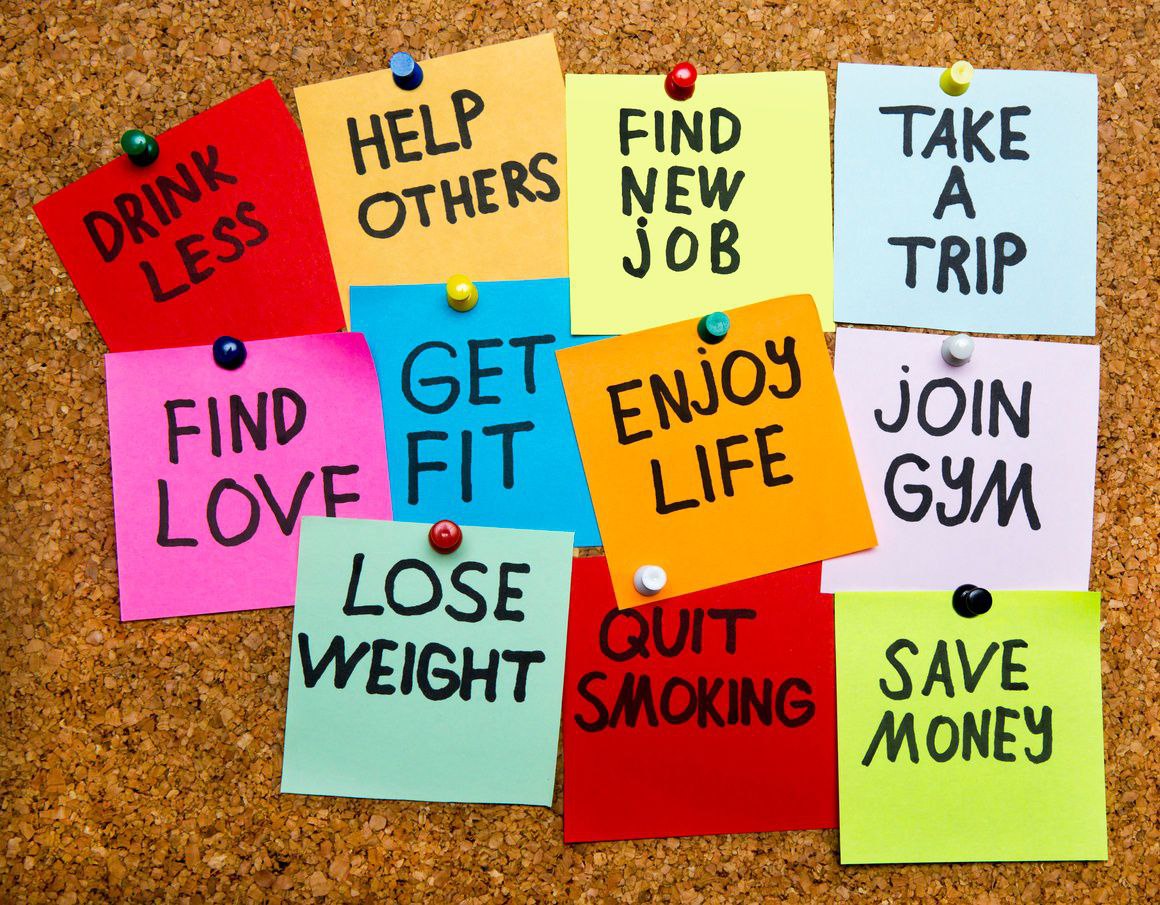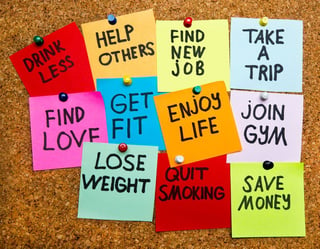
Reflections on Leadership: New Year’s Resolutions – Setting Goals, Shaping Habits, Finding Meaning
The beginning of a new year is typically a time of reflection and change. Television programs feature special segments on self-improvement that involves making resolutions to change something for the better. The following is a list of the most common New Year’s resolutions taken from several sources (listed in no particular order):
- Spend more time with family and friends
- Enjoy life more
- Drink less alcohol
- Learn something new
- Get fit
- Lose weight – tame the bulge
- Reduce debt
- Manage stress
- Quit smoking
- Reduce, reuse, and recycle
- Save money
- Travel to new places
- Help others
- Get Organized
 If you cannot find something on this list that appeals to you, do not despair. There are web sites to help you with your New Year’s resolutions, including a list of Top 50 New Year Resolutions, and a New Year’s Resolution Worksheet. If you are interested in making this a family experience, there is even a Top 10 New Year’s Resolutions for Teens. I have to admit that when my children were teenagers, I did not have the courage to engage them in this kind of process. This proves that even optimistic people know their limits.
If you cannot find something on this list that appeals to you, do not despair. There are web sites to help you with your New Year’s resolutions, including a list of Top 50 New Year Resolutions, and a New Year’s Resolution Worksheet. If you are interested in making this a family experience, there is even a Top 10 New Year’s Resolutions for Teens. I have to admit that when my children were teenagers, I did not have the courage to engage them in this kind of process. This proves that even optimistic people know their limits.
Every year my New Year’s resolution setting begins with a look back on the list of resolutions from last year to gauge my progress and make up a new list. Many of the same things appear year after year. Losing weight, devoting more time to family, developing a better sense of work / life balance, reading and educational goals, all seem to reappear when the new list is made. I do better on some than others, but the list seems to be nearly the same every year.
The few occasions when I have managed to successfully make and keep a New Year’s resolution throughout the year have been a combination of goal setting and forming good habits that made sure that I did not fall back into my prior behavior. Charles Duhigg, the New York Times best-selling author has written extensively on setting goals and forming new habits. His books, Better, Smarter, Faster, The Secrets of Being Productive in Life and Business, and The Power of Habit, Why We Do What We Do in Life and Business, offer great insights on goal setting and how habits work.
Setting Goals
Even knowing that resolutions are so hard to keep we insist on going through the exercise of setting goals. This is because we know that goals are needed in every phase of life if we are to move forward. Resolutions are most likely to be kept if you create a plan, write down your resolution and plan, think about the goal as a year round activity, and remain flexible. There is nothing earth shattering in this approach. It is good, common sense advice, but it is also backed up by research.
According to Duhigg, the process of goal setting has a powerful effect on motivation. He states that “When people believe that they are in control they tend to work harder and push themselves more.” Life is full of choices, and when you make choices you have a feeling that you are in charge. So the process of reflection and setting goals is by its very nature an empowering exercise.
But just setting a goal is not enough - the way you set goals is important. Duhigg highlights a goal setting process used at General Electric (GE) called SMART goals. SMART is an acronym for: Specific, Measurable, Achievable, Realistic, and Timeline. According to those who study goal setting, breaking a goal into SMART components is the difference between hoping something comes true and figuring out how to do it. But GE eventually found out that applying SMART goals was insufficient, because it was possible to follow the process while concentrating on areas that were not critical for success. So GE added stretch goals  – identifying areas that were both challenging and important. The key to stretch goals was to find a goal that is challenging, but not so far out of reach that it crushed morale. For GE and other companies, combining SMART thinking and stretch goals created the right combination for success. Personal applications of this approach are not hard to imagine.
– identifying areas that were both challenging and important. The key to stretch goals was to find a goal that is challenging, but not so far out of reach that it crushed morale. For GE and other companies, combining SMART thinking and stretch goals created the right combination for success. Personal applications of this approach are not hard to imagine.
Shaping Habits
All human beings are creatures of habit. Some habits are good, while others are not so good. Most of the goals we set (including New Year’s resolutions) involve changing an old habit or embracing a new one. The key to self-discipline seems to be found in finding ways to override bad habits that hold us back, and to embrace new habits that help us to reach our desired goals.
Some people seem to have an easier time than the rest of us when it comes to embracing life changing habits. I have a friend who is about my age (in his 60’s) who is an ultra marathoner. He travels around the country to competitively race in these 50 mile events. His ability to do this is rooted in a daily routine that includes getting up at 4:00 am and running in excess of 10 miles every morning. I suspect that this is not a carefully considered decision at the start of each day. It is a habit that is the result of making a scheduling decision at some point in time and sticking with it.
Research tells us that habits cannot be eradicated – they must instead, be replaced. The key to replacement is to find an alternate routine, and if possible, find the support of others to help you make the change permanent. All of this sounds easy, but is extremely difficult – and the reason why many New Year’s resolutions do not result in permanent change. Just drive by the parking lot of any fitness center in January and you can get an idea of how many people have good intentions. Return in to the same parking lot in April, and you will see a much smaller crowd.
Finding Meaning
As important as setting goals and changing habits can be in improving life circumstances, there are limits to what can be achieved using this approach. It is entirely possible for a person to set impressive goals, embrace an entirely new set of good habits permanently change their way of living, and still be unfulfilled at the end of the day.
Tim Keller, noted author and pastor of Redeemer Presbyterian Church in New York City, has written frequently about finding meaning in life. In his recent book, Making Sense Out of God, he states, “To have meaning in life is to have both an overall purpose for living and  the assurance that you are making a difference by serving some good beyond yourself.” He further observes “even those who have good jobs, family and friends, and live in a materially comfortable way need to understand what that activity is being done for”.
the assurance that you are making a difference by serving some good beyond yourself.” He further observes “even those who have good jobs, family and friends, and live in a materially comfortable way need to understand what that activity is being done for”.
Fully understanding and appreciating the value of having a meaningful life may be the first step in making New Year’s resolutions that go well beyond superficial goals that, even when achieved, do not provide lasting satisfaction.
My New Year’s wish for all of you is that in addition to making and successfully keeping your New Year’s resolutions, you find meaning and true happiness in 2017.
About Steve Proctor
As the now-retired CEO of Presbyterian Senior Living, Mr. Proctor was employed by PSL from 1971 - 2019. He is a Registered Nurse and Licensed Nursing Home Administrator with a BS degree in business administration from Elizabethtown College. He also holds a master’s degree in gerontology from the University of North Texas. Before becoming CEO, Mr. Proctor was Chief Operating Officer for 16 years. In addition, he has served as a Board member and is a Past President of the Pennsylvania Association of Non-Profit Homes for the Aging (“PANPHA”). In November of 1995, the American Association of Homes and Services for the Aging (“AAHSA”), now known as LeadingAge, recognized Mr. Proctor’s proven leadership and accomplishments by electing him to serve as Chair of its national board of directors. He served as Chair-elect in 1996 and 1997, as Chair in 1998 and 1999, and as past-Chair in 2000 and 2001. He has also served as chair of the International Association of Homes and Services for the Aging.

